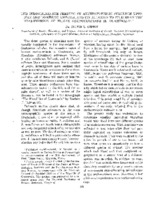Los simúlidos y su relación con la oncocercosis humana en Venezuela septentrional
| dc.contributor.author | Lewis, D. J | es_ES |
| dc.contributor.author | Ibañez de Aldecoa, R | es_ES |
| dc.date.accessioned | 2015 | |
| dc.date.available | 2015 | |
| dc.date.issued | s.d. | es_ES |
| dc.date.issued | 1964 | es_ES |
| dc.identifier.uri | https://iris.paho.org/handle/10665.2/14477 | |
| dc.description.abstract | During a study carried out near San Antonio de Maturín, Venezuela, 12 Simulium forms were encountered, among which Simulium exiguum was abundant but of uncertain relation to onchocerciasis. As opposed to S. metallicum, which has its breeding places almost exclusively in small streams, S. exiguum breeds in big streams. In neither species is it possible to distinguish nuliparous and parous females from the size of their organism so it is necessary to examine the ovaries. During the rainy season pupae are swept away and the S. metallicum population is reduced | en_US |
| dc.description.abstract | Generally speaking, adult S. exiguum have mostly been caputrd near large streams whereas adult S. metallicum have been primarily encountered near small streams. Besides these two species, two others have been caught on man. Unlike the other species which bite man and donkeys indistinctively, S. metallicum has a distinct preference for man. In the course of catches of S. exiguum, it was observed that the proportion of parous flies tended to increase after 1600 hours. Unlike what has been observed with captured individulas, reared S. exiguum were frequently found to have encysted metacercariae of a digenetic trematode. The parasite is often found in the head of the insect which is finally destroyed or prevented from biting man. Among these same simuliidae, carriers of mermithids are also found | en_US |
| dc.description.abstract | The dissection of simuliidae showed that the ...(AU) | es_ES |
| dc.description.abstract | Publicado en inglés en el Bull. WHO 27(4-5), 1962 | es_ES |
| dc.format.extent | Tab | es_ES |
| dc.relation.ispartofseries | Boletín de la Oficina Sanitaria Panamericana (OSP);56(1),ene. 1964 | es_ES |
| dc.subject | Oncocercose | es_ES |
| dc.subject | Oncocercose | es_ES |
| dc.subject | Esquistossomose | es_ES |
| dc.subject | Esquistossomose | es_ES |
| dc.subject | Simuliidae | es_ES |
| dc.subject | DDT | es_ES |
| dc.subject | Inquéritos Epidemiológicos | es_ES |
| dc.subject | Venezuela | es_ES |
| dc.title | Los simúlidos y su relación con la oncocercosis humana en Venezuela septentrional | es_ES |
| dc.title.alternative | Simuliidae and their relation to human onchocerciases in Northern Venezuela | en_US |
| dc.type | Journal articles | en_US |
| dc.rights.holder | Pan American Health Organization | en_US |
Files in this item
This item appears in the following Collection(s)
-
Pan American Journal of Public Health
Revista Panamericana de Salud Pública




